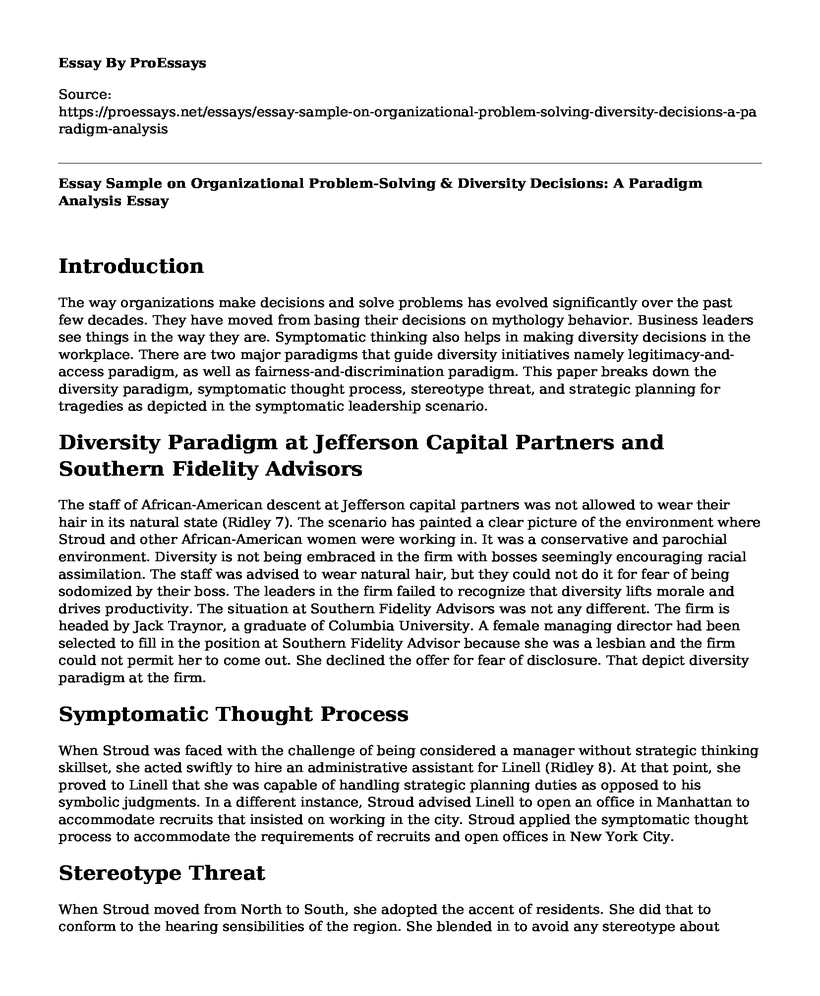Introduction
The way organizations make decisions and solve problems has evolved significantly over the past few decades. They have moved from basing their decisions on mythology behavior. Business leaders see things in the way they are. Symptomatic thinking also helps in making diversity decisions in the workplace. There are two major paradigms that guide diversity initiatives namely legitimacy-and-access paradigm, as well as fairness-and-discrimination paradigm. This paper breaks down the diversity paradigm, symptomatic thought process, stereotype threat, and strategic planning for tragedies as depicted in the symptomatic leadership scenario.
Diversity Paradigm at Jefferson Capital Partners and Southern Fidelity Advisors
The staff of African-American descent at Jefferson capital partners was not allowed to wear their hair in its natural state (Ridley 7). The scenario has painted a clear picture of the environment where Stroud and other African-American women were working in. It was a conservative and parochial environment. Diversity is not being embraced in the firm with bosses seemingly encouraging racial assimilation. The staff was advised to wear natural hair, but they could not do it for fear of being sodomized by their boss. The leaders in the firm failed to recognize that diversity lifts morale and drives productivity. The situation at Southern Fidelity Advisors was not any different. The firm is headed by Jack Traynor, a graduate of Columbia University. A female managing director had been selected to fill in the position at Southern Fidelity Advisor because she was a lesbian and the firm could not permit her to come out. She declined the offer for fear of disclosure. That depict diversity paradigm at the firm.
Symptomatic Thought Process
When Stroud was faced with the challenge of being considered a manager without strategic thinking skillset, she acted swiftly to hire an administrative assistant for Linell (Ridley 8). At that point, she proved to Linell that she was capable of handling strategic planning duties as opposed to his symbolic judgments. In a different instance, Stroud advised Linell to open an office in Manhattan to accommodate recruits that insisted on working in the city. Stroud applied the symptomatic thought process to accommodate the requirements of recruits and open offices in New York City.
Stereotype Threat
When Stroud moved from North to South, she adopted the accent of residents. She did that to conform to the hearing sensibilities of the region. She blended in to avoid any stereotype about people from the North. She enhanced her communications to make colleagues who found her speech was fast comfortable (Ridley 8). Additionally, when Beverly Todd was experiencing a stereotype threat, she came in swiftly to administer discipline. She had noticed the behavioral dynamic of Todd after Lavery brought it to her attention. In this context, fending off the stereotype means to discipline or make a person leave his stereotyping tendencies.
Strategic Planning for Tragedies
A strategic plan is necessary to aid disaster recovery when a tragedy such as the September 11 tragedy occurs. Stroud can make her firm prepared by putting in place a business impact analysis mechanism to find out the effects of various threats. It will also help with the headcount problem faced by Stroud's firm (Senge, Peter, Hamilton, and Kania 31). It will be part of a business continuity plan that will drive employee responsiveness in such situations, ease confusions as well as aid in making logical decisions.
Conclusion
Stroud has applied asymptomatic thought process in her management style, and it has manifested itself in the way she is making decisions about strategic expansions and recruitments. Stroud has also overcome stereotype threat in various ways including conforming to the accent of the residents and going above the stereotypic standards set in the workplace. A good strategic plan for disaster management for Stroud to implement would be having a business impact analysis in place.
Works Cited
Ridley, Linda L. "Symptomatic Leadership: The impact of changing demographics on global business." (2016). Accessed from https://academicworks.cuny.edu/ho_pubs/31/
Senge, Peter, Hal Hamilton, and John Kania. "The dawn of system leadership." Stanford Social Innovation Review 13.1 (2015): 27-33. Accessed from https://networkpeninsula.org/wp-content/uploads/2014/12/The_Dawn_of_System_Leadership-1.pdf
Cite this page
Essay Sample on Organizational Problem-Solving & Diversity Decisions: A Paradigm Analysis. (2023, Feb 12). Retrieved from https://proessays.net/essays/essay-sample-on-organizational-problem-solving-diversity-decisions-a-paradigm-analysis
If you are the original author of this essay and no longer wish to have it published on the ProEssays website, please click below to request its removal:
- Organization Theory, Behavior, Organic Organization, Mechanic Organization Mission and Vision Statement
- Evaluation of User Manuals
- Competent Organizational Leadership of Coca-Cola Company
- Competition and Bankruptcy of General Motors SWOT Analysis
- Essay Example on Daimler: An Icon of Luxury and Innovation Since 1886
- Strengthening Household Appliances Supply Chain Risk Management - Essay Sample
- Morning Star: A Unique Organizational Structure and SHRM Model - Essay Sample







